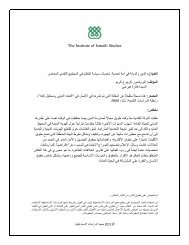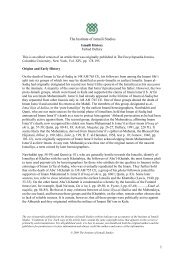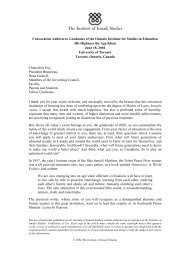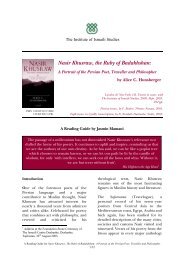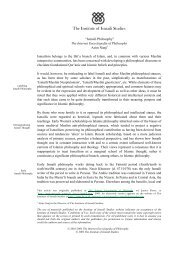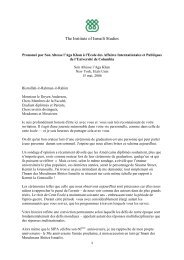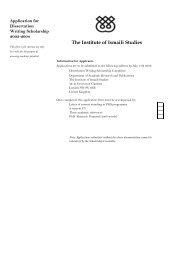Surviving the Mongols: Nizari Quhistani and the Continuity
Surviving the Mongols: Nizari Quhistani and the Continuity
Surviving the Mongols: Nizari Quhistani and the Continuity
Create successful ePaper yourself
Turn your PDF publications into a flip-book with our unique Google optimized e-Paper software.
The Institute of Ismaili Studies<br />
<strong>Surviving</strong> <strong>the</strong> <strong>Mongols</strong>: <strong>Nizari</strong> <strong>Quhistani</strong> <strong>and</strong> <strong>the</strong> <strong>Continuity</strong> of<br />
Ismaili Tradition in Persia<br />
By Nadia Eboo Jamal<br />
London & New York: I.B. Tauris in association with<br />
The Institute of Ismaili Studies, 2002.<br />
190 pp. ISBN 1 86064 432 5 (HB), 1 86064 876 2 (PB)<br />
A Reading Guide by Fayaz S. Alibhai ∗<br />
Introduction<br />
It is well that you should follow <strong>the</strong> Imamate,<br />
For <strong>the</strong> Light of God is within his pure heart.<br />
Through that Light you will be freed from darkness.<br />
Follow that Light <strong>and</strong> may peace be with you!<br />
<strong>Nizari</strong> <strong>Quhistani</strong>, Dastur-nama<br />
Thus begins Nadia Eboo Jamal’s book<br />
entitled <strong>Surviving</strong> <strong>the</strong> <strong>Mongols</strong>: <strong>Nizari</strong><br />
<strong>Quhistani</strong> <strong>and</strong> <strong>the</strong> <strong>Continuity</strong> of Ismaili<br />
Tradition in Persia. Presented in two<br />
parts, this moving <strong>and</strong> highly readable<br />
book cannot but evoke not only a<br />
proud memory of Ismaili history, but<br />
also a sense of <strong>the</strong> place of <strong>the</strong> Ismailis<br />
in, <strong>and</strong> <strong>the</strong>ir contributions to, <strong>the</strong><br />
developments of Muslim history,<br />
thought, cultures <strong>and</strong> traditions.<br />
Jamal’s work demonstrates <strong>the</strong> courage,<br />
<strong>the</strong> resilience, <strong>the</strong> determination, <strong>the</strong><br />
intellectual heights, <strong>and</strong> <strong>the</strong> abiding<br />
faith of <strong>the</strong> Ismailis over <strong>the</strong> course of<br />
<strong>the</strong>ir history. This is especially <strong>the</strong> case<br />
with her account of <strong>the</strong> <strong>Nizari</strong> Ismailis<br />
of Persia <strong>and</strong> to a lesser extent, Syria,<br />
who in <strong>the</strong> 7 th /13 th century under <strong>the</strong><br />
∗ Education Officer, IIS-ITREB Liaison Department, The Institute of Ismaili Studies, London, July 2003. My<br />
sincere thanks go to Dr. Karim Janmohamed <strong>and</strong> Mr. Kutub Kassam who gave generously of <strong>the</strong>ir time in<br />
reviewing earlier drafts of this guide as well as offering extensive <strong>and</strong> very helpful comments. Any errors that<br />
remain are, of course, mine alone.<br />
A Reading Guide for <strong>Surviving</strong> <strong>the</strong> <strong>Mongols</strong>: <strong>Nizari</strong> <strong>Quhistani</strong> <strong>and</strong> <strong>the</strong> <strong>Continuity</strong> of Ismaili Tradition in Persia<br />
1/17
invasion of <strong>the</strong> <strong>Mongols</strong>, suffered <strong>the</strong><br />
destruction of <strong>the</strong> strongholds that<br />
constituted <strong>the</strong>ir state, <strong>the</strong> massacres of<br />
<strong>the</strong>ir communities, <strong>the</strong> loss of <strong>the</strong>ir<br />
literature, <strong>and</strong> <strong>the</strong> murder of <strong>the</strong>ir<br />
Imam. This destruction <strong>and</strong> bloodshed<br />
was visited not only upon <strong>the</strong> Ismailis<br />
but also “upon millions of o<strong>the</strong>r<br />
Muslims from <strong>the</strong> Central Asian steppes<br />
to <strong>the</strong> shores of <strong>the</strong> Mediterranean<br />
Sea” (p. 50-1).<br />
<strong>Surviving</strong> <strong>the</strong> <strong>Mongols</strong> is thus invaluable<br />
for those who wish to discover more<br />
about this particular group of Ismailis<br />
as its members attempted not only to<br />
maintain <strong>the</strong>ir religious identity but<br />
also to remain a cohesive community in<br />
dangerous <strong>and</strong> deeply hostile times. It<br />
is also a rich source of information for<br />
those who want to gain an intimate<br />
insight into <strong>the</strong> life <strong>and</strong> times of a<br />
remarkable individual who witnessed<br />
both <strong>the</strong> great destruction <strong>the</strong> <strong>Mongols</strong><br />
wreaked upon his homel<strong>and</strong> as well as<br />
<strong>the</strong> massacre of his own community of<br />
Ismailis.<br />
Part One of <strong>the</strong> book, The Ismaili<br />
Da
The author begins this chapter by<br />
asserting that <strong>the</strong> modern study of<br />
Ismaili history is conceived linearly,<br />
based as it is on a combination of a<br />
variety of chronological, doctrinal,<br />
geographical <strong>and</strong> o<strong>the</strong>r factors. It thus<br />
st<strong>and</strong>s in sharp contrast to <strong>the</strong> cyclical<br />
view of time <strong>and</strong> history in early Ismaili<br />
thought. This underst<strong>and</strong>ing of cyclical<br />
time<br />
became <strong>the</strong> framework of a highly<br />
complex meta-historical system,<br />
integrating cosmology, prophetology,<br />
soteriology <strong>and</strong> eschatology within <strong>the</strong><br />
perspectives of Shian, Prophetic Tradition <strong>and</strong> <strong>the</strong><br />
teachings of <strong>the</strong> early Shi
community’s sense of historical<br />
purpose, but also came to be embodied<br />
Ithna
surrounding areas of Persia to preach<br />
in <strong>the</strong> name of <strong>the</strong> hidden Imam.<br />
However, it was during <strong>the</strong> Imamate of<br />
Quick Review<br />
Who was Hasan-i Sabah <strong>and</strong> why is he such an<br />
important figure in Ismaili history?<br />
For <strong>the</strong> majority of Ismailis in different<br />
parts of <strong>the</strong> Muslim world, <strong>the</strong> da
Quick Review<br />
1. Who were <strong>the</strong> <strong>Mongols</strong>?<br />
2. Explain why <strong>the</strong> Mongol invasion was one of <strong>the</strong> most<br />
catastrophic events to befall <strong>the</strong> Muslim world.<br />
not to mention boldness, enabled <strong>the</strong><br />
Persian Ismailis to seize control of<br />
numerous o<strong>the</strong>r “strategically placed<br />
fortresses, towns <strong>and</strong> villages in <strong>the</strong><br />
surrounding areas of Rudbar as well as<br />
Quhistan in sou<strong>the</strong>rn Khurasan” (p.<br />
34).<br />
For twenty years, Hasan-i Sabah not<br />
only continued to intensify <strong>the</strong> da
<strong>the</strong> ferocity of <strong>the</strong>ir conquests<br />
unprecedented in history (p. 44).<br />
Indeed, <strong>the</strong> Mongol invasion was “one<br />
of <strong>the</strong> most catastrophic events to befall<br />
<strong>the</strong> Muslim world” (p. 1) <strong>and</strong> culminated<br />
in <strong>the</strong> sacking of Baghdad <strong>and</strong><br />
<strong>the</strong> destruction of <strong>the</strong> Abbasid<br />
caliphate in 656 AH/1258 CE.<br />
Exterminating <strong>the</strong> Ismailis was for <strong>the</strong><br />
<strong>Mongols</strong> “a small but necessary step”<br />
(p. 50) towards this end. In <strong>the</strong> arenas<br />
of economics, politics <strong>and</strong> religion, <strong>the</strong><br />
<strong>Mongols</strong> effectively disrupted<br />
<strong>the</strong> emergence of new patterns of<br />
thought <strong>and</strong> social organisation in <strong>the</strong><br />
Muslim world at a time when Western<br />
Europe was making a historically<br />
decisive transition from feudalism to<br />
<strong>the</strong> construction of a new social,<br />
economic <strong>and</strong> political order (p. 2).<br />
It was under Chingiz Khan (d. 625<br />
AH/1227 CE) that <strong>the</strong> Mongol tribes<br />
became a powerful force who “carved<br />
out a vast Eurasian empire stretching<br />
from <strong>the</strong> Sea of Japan to <strong>the</strong> shores of<br />
After <strong>the</strong> Mongol invasion, <strong>the</strong> Ismailis “were never again<br />
able to exercise <strong>the</strong> same degree of…influence [as] <strong>the</strong>y<br />
did in <strong>the</strong> preceding four or five centuries of Islam.”<br />
<strong>the</strong> Caspian Sea <strong>and</strong> from <strong>the</strong> Volga<br />
plains of Russia to <strong>the</strong> River basin of<br />
Transoxania” (p. 44).<br />
Balkh, <strong>the</strong> <strong>Mongols</strong> massacred <strong>the</strong><br />
inhabitants, laying waste to <strong>the</strong>se once<br />
prosperous cities. Marw <strong>and</strong> Nishapur<br />
in <strong>the</strong> Khurasan province of nor<strong>the</strong>astern<br />
Persia were also ravaged.<br />
Bent on exp<strong>and</strong>ing <strong>the</strong>ir empire,<br />
Chingiz Khan’s successors, Ogedei,<br />
Guyuk <strong>and</strong> Mongke sought to gain<br />
control over <strong>the</strong> whole of western Asia.<br />
And so it was, that “in 650/1252<br />
Mongke despatched his bro<strong>the</strong>r<br />
Hulegu to spearhead <strong>the</strong> conquest of<br />
<strong>the</strong> Persian-speaking l<strong>and</strong>s south <strong>and</strong><br />
west of <strong>the</strong> Oxus river” (p. 45).<br />
The first encounter between <strong>the</strong><br />
Ismailis <strong>and</strong> <strong>the</strong> <strong>Mongols</strong> occurred<br />
within a year in 651 AH/1253 CE, when<br />
Mongol troops captured a number of<br />
Ismaili strongholds in Quhistan, killing<br />
its inhabitants <strong>and</strong> besieging <strong>the</strong><br />
fortress of Girdkuh.<br />
According to<br />
one report, “some<br />
12,000 Ismailis were<br />
killed in <strong>the</strong> town of Tun alone on <strong>the</strong><br />
orders of Hulegu” (p. 46).<br />
In Central Asia, where <strong>the</strong>y passed<br />
through Bukhara, Samarq<strong>and</strong> <strong>and</strong><br />
Three years later, in 654 AH/1256 CE,<br />
Hulegu <strong>and</strong> his army crossed <strong>the</strong> Oxus<br />
A Reading Guide for <strong>Surviving</strong> <strong>the</strong> <strong>Mongols</strong>: <strong>Nizari</strong> <strong>Quhistani</strong> <strong>and</strong> <strong>the</strong> <strong>Continuity</strong> of Ismaili Tradition in Persia<br />
8/17
iver into Khurasan. Tun was<br />
recaptured <strong>and</strong> Hulegu ordered that<br />
all of its inhabitants be slaughtered,<br />
with <strong>the</strong> exception of younger women<br />
<strong>and</strong> children. This led <strong>the</strong> Ismaili<br />
governor of Quhistan to surrender to<br />
<strong>the</strong> <strong>Mongols</strong>. It also forced <strong>the</strong> Imam<br />
Rukn al-Din Khurshah (ca. 627<br />
AH/1230 CE – 655AH/1257 CE) to<br />
despatch his bro<strong>the</strong>r with a message of<br />
submission to Hulegu. Hulegu,<br />
however, dem<strong>and</strong>ed that <strong>the</strong> Imam<br />
“surrender in person <strong>and</strong> instruct his<br />
followers to demolish all <strong>the</strong>ir<br />
fortresses in <strong>the</strong> country” (p. 47).<br />
Jamal <strong>the</strong>n goes on to detail <strong>the</strong><br />
captivity <strong>and</strong> murder of <strong>the</strong> Imam<br />
under <strong>the</strong> <strong>Mongols</strong>, <strong>and</strong> <strong>the</strong> brutality<br />
<strong>and</strong> destruction visited upon <strong>the</strong> Ismaili<br />
strongholds.<br />
The Mongol invasion had a lasting<br />
impact<br />
on <strong>the</strong> Ismaili community as a whole<br />
<strong>and</strong> <strong>the</strong> <strong>Nizari</strong>s of Persia in particular,<br />
who were never again able to exercise<br />
<strong>the</strong> same degree of political,<br />
intellectual <strong>and</strong> religious influence<br />
which <strong>the</strong>y did in <strong>the</strong> preceding four<br />
or five centuries of Islam (p. 51).<br />
Decimated but not annihilated,<br />
contrary to <strong>the</strong> reports of<br />
contemporary Muslim historians, <strong>the</strong><br />
Ismaili community survived, as did <strong>the</strong><br />
line of <strong>the</strong>ir Imams after Imam Rukn<br />
al-Din Khurshah. Indeed,<br />
<strong>the</strong> son<br />
<strong>and</strong> successor of Imam Rukn al-Din<br />
Khurshah, Imam Shams al-Din<br />
Muhammad (r. 655 AH/1257 CE – ca.<br />
710 AH/1310 CE)<br />
is reported to have been concealed by<br />
a group of da
fragmented <strong>and</strong> displaced, <strong>the</strong>y<br />
became one of many communities who<br />
moved en-masse from rural to urban<br />
areas, seeking security <strong>and</strong> a better life.<br />
Part Two: <strong>Nizari</strong> <strong>Quhistani</strong>: The<br />
Search for Meaning <strong>and</strong> Identity<br />
We turn now to <strong>the</strong> second part of <strong>the</strong><br />
book, where Jamal attempts to examine<br />
“some of <strong>the</strong> strategies <strong>the</strong> Ismailis may<br />
have used to maintain <strong>the</strong>ir beliefs <strong>and</strong><br />
sense of identity as a distinctive Muslim<br />
community” (p. 53). She does this<br />
through an analysis of <strong>the</strong> life <strong>and</strong><br />
writings of <strong>the</strong> poet <strong>Nizari</strong><br />
<strong>Quhistani</strong>, “who lived in <strong>the</strong> years<br />
immediately after <strong>the</strong> fall of Alamut<br />
<strong>and</strong> whose writings constitute <strong>the</strong> main<br />
source of information on <strong>the</strong> Ismailis of<br />
this period” (p. 53).<br />
The Poet <strong>Nizari</strong> <strong>Quhistani</strong><br />
Apart from <strong>the</strong> fact that <strong>the</strong> poetical<br />
works of <strong>Nizari</strong> <strong>Quhistani</strong> remain one<br />
of <strong>the</strong> few major Ismaili source<br />
materials to have survived Mongol rule,<br />
Jamal’s study of <strong>Nizari</strong> is important for<br />
at least three o<strong>the</strong>r reasons:<br />
1. His Safar-nama (Travelogue)<br />
enables us to explore how <strong>the</strong><br />
<strong>Nizari</strong> Ismailis survived <strong>and</strong> were<br />
able to continue <strong>the</strong>ir traditions<br />
under Mongol rule.<br />
2. His writings provide a<br />
fascinating insight into how<br />
Ismailism <strong>and</strong> Sufism interfaced<br />
with each o<strong>the</strong>r during this time.<br />
3. <strong>Nizari</strong>’s works are largely<br />
unknown to <strong>the</strong> Englishspeaking<br />
world. As such, this<br />
study is particularly useful in<br />
introducing <strong>the</strong> general reader<br />
to his life <strong>and</strong> poetry.<br />
Quick Review<br />
1. Who was <strong>Nizari</strong> <strong>Quhistani</strong> <strong>and</strong> why are his<br />
writings an important resource of study?<br />
<strong>Nizari</strong> <strong>Quhistani</strong>’s life was spent almost<br />
entirely under Mongol rule in Persia,<br />
where he was witness to <strong>the</strong> enormous<br />
destruction caused by <strong>the</strong> Mongol<br />
invaders of his homel<strong>and</strong>, including<br />
<strong>the</strong> massacres of his own community of<br />
Ismailis. <strong>Nizari</strong> was born in 645 AH<br />
/1247 CE in Birj<strong>and</strong>, <strong>the</strong> south-eastern<br />
part of <strong>the</strong> mountainous region of<br />
Quhistan in <strong>the</strong> province of Khurasan.<br />
He seems to have gained poetic fame at<br />
<strong>the</strong> courts of <strong>the</strong> local rulers governing<br />
Khurasan <strong>and</strong> Quhistan on behalf of<br />
<strong>the</strong> <strong>Mongols</strong> in <strong>the</strong> second half of <strong>the</strong><br />
A Reading Guide for <strong>Surviving</strong> <strong>the</strong> <strong>Mongols</strong>: <strong>Nizari</strong> <strong>Quhistani</strong> <strong>and</strong> <strong>the</strong> <strong>Continuity</strong> of Ismaili Tradition in Persia<br />
10/17
7 th /13 th century. Over time, however,<br />
his dissatisfaction with <strong>and</strong> criticism of<br />
<strong>the</strong> policies of <strong>the</strong> ruling classes<br />
resulted in his dismissal <strong>and</strong> exile to<br />
<strong>the</strong> countryside. Poverty-stricken,<br />
<strong>Nizari</strong> became an obscure figure,<br />
writing until his death in 720 AH/1320<br />
CE.<br />
Despite <strong>the</strong> high quality of <strong>Nizari</strong>’s<br />
poetry, his work is neglected partly because<br />
of its rarity <strong>and</strong> inaccessibility<br />
until recent times. Also, <strong>the</strong> political<br />
<strong>and</strong> religious milieu of his time “was<br />
extremely hostile towards <strong>the</strong> Ismailis,<br />
[<strong>and</strong>] discouraged <strong>the</strong> study <strong>and</strong><br />
dissemination of his works” (p. 58).<br />
account of <strong>the</strong> final years of his life. All<br />
of <strong>the</strong>se sections are interspersed with<br />
extracts of his poetry, “which is<br />
substantial, multifaceted <strong>and</strong> of a high<br />
literary quality, deserving a separate<br />
study of its own” (p. 83).<br />
<strong>Nizari</strong>’s works are also interesting for<br />
anecdotal material about <strong>the</strong> social <strong>and</strong><br />
economic conditions in Khurasan <strong>and</strong><br />
Quhistan under Mongol rule. In <strong>the</strong>se<br />
terms, says <strong>the</strong> author,<br />
<strong>Nizari</strong> st<strong>and</strong>s out among <strong>the</strong> Persian<br />
poets of his generation for <strong>the</strong><br />
uncompromising honesty <strong>and</strong> courage<br />
with which he denounced <strong>the</strong><br />
corruption <strong>and</strong> injustices of his time,<br />
<strong>and</strong> for championing <strong>the</strong> cause of<br />
those people who suffered most from<br />
<strong>the</strong>se conditions (p. 83).<br />
Ismailism, Sufism <strong>and</strong> <strong>Nizari</strong> <strong>Quhistani</strong><br />
The author delves into great detail<br />
As has been mentioned earlier, <strong>the</strong><br />
about <strong>the</strong> origin of <strong>Nizari</strong>’s name <strong>and</strong><br />
Quick Review<br />
If <strong>the</strong> <strong>Mongols</strong> Mongol had, in rulers effect, were a policy not of particularly religious tolerance,<br />
<strong>the</strong> debates surrounding his identity<br />
why did concerned <strong>the</strong>y persecute with <strong>the</strong> <strong>the</strong> religious <strong>Nizari</strong> beliefs Ismailis? of<br />
<strong>and</strong> religious affiliation. Most scholars<br />
<strong>the</strong> people <strong>the</strong>y conquered. In effect,<br />
today, however, agree that <strong>Nizari</strong><br />
<strong>the</strong>y tolerated religious difference <strong>and</strong><br />
<strong>Quhistani</strong> was definitely an Ismaili.<br />
freedom of worship. Their persecution<br />
of <strong>the</strong> Ismailis was a policy “dictated<br />
Using what is available in <strong>the</strong> sources<br />
mainly by political factors, based on<br />
<strong>and</strong> in his writings, Jamal also attempts<br />
<strong>the</strong>ir perception of <strong>the</strong> Ismailis as a<br />
to reconstruct <strong>Nizari</strong>’s early life <strong>and</strong><br />
continuing military threat to <strong>the</strong>ir rule”<br />
education, his career in Harat <strong>and</strong> later<br />
(p. 85).<br />
in Birj<strong>and</strong>, before concluding with an<br />
A Reading Guide for <strong>Surviving</strong> <strong>the</strong> <strong>Mongols</strong>: <strong>Nizari</strong> <strong>Quhistani</strong> <strong>and</strong> <strong>the</strong> <strong>Continuity</strong> of Ismaili Tradition in Persia<br />
11/17
policy of religious tolerance mentioned<br />
With this exception, <strong>the</strong> Mongol policy<br />
of religious tolerance resulted in “<strong>the</strong><br />
gradual erosion of some of <strong>the</strong> tensions<br />
that had previously divided various<br />
religions <strong>and</strong> sects under <strong>the</strong> Saljuqs”<br />
(p. 85), a factor that contributed to <strong>the</strong><br />
gradual resurgence of Twelver Shi
focusing on <strong>Nizari</strong>’s relations with<br />
Sufism. This latter issue is an important<br />
one, for Sufism is a distinctive<br />
aspect of <strong>Nizari</strong>’s poetry which<br />
“continues to remain a matter of much<br />
curiosity <strong>and</strong> obscurity” (p. 84) despite<br />
general scholarly acceptance of his<br />
Ismaili identity.<br />
<strong>Nizari</strong> was <strong>the</strong> first Ismaili writer to<br />
move away “from <strong>the</strong> poetic styles <strong>and</strong><br />
conventions of <strong>the</strong> earlier Ismaili<br />
literary tradition of <strong>the</strong> Fatimid<br />
period,” (p. 93) such as those of al-<br />
Mu>ayyad fi>l-Din al-Shirazi in Arabic<br />
<strong>and</strong> Nasir-i Khusraw in Persian.<br />
Fur<strong>the</strong>rmore, his familiarity with Sufi<br />
<strong>the</strong>ory <strong>and</strong> practice has made it<br />
difficult to separate his Sufism from<br />
Ismailism. Jamal thus pauses to “review<br />
briefly how <strong>Nizari</strong> defines his own<br />
position vis-à-vis <strong>the</strong> Sufis <strong>and</strong> o<strong>the</strong>r<br />
religious communities among whom he<br />
lived” (p. 94). This she does by<br />
highlighting <strong>Nizari</strong>’s references to<br />
imamah, <strong>and</strong> <strong>the</strong> notion of wilaya or<br />
spiritual authority, around which <strong>the</strong><br />
Sunnis, Twelver Shi
works not only because its highly<br />
autobiographical content is a valuable<br />
source of information about his life<br />
<strong>and</strong> activities, but also because this<br />
1,200-verse example of a mathnawi is<br />
perhaps his most explicit ‘Ismaili’ work,<br />
alluding frequently <strong>and</strong> throughout to<br />
Ismaili doctrines <strong>and</strong> ideas. Jamal<br />
contextualises <strong>Nizari</strong>’s journey <strong>and</strong><br />
compares <strong>and</strong> contrasts it in detail with<br />
<strong>the</strong> one made by Nasir-i Khusraw, “his<br />
more illustrious Ismaili forbearer of <strong>the</strong><br />
5 th /11 th century, <strong>the</strong> Fatimid poet,<br />
<strong>the</strong>ologian, philosopher <strong>and</strong> chief da
Quick Review<br />
1. Why is <strong>Nizari</strong> <strong>Quhistani</strong>’s Safar-nama a<br />
particularly important work?<br />
2 What are its key <strong>the</strong>mes?<br />
states that in writing this mathnawi, he<br />
had risen to a major post in <strong>the</strong><br />
aimed not just to tell an interesting<br />
story, but also, more importantly, as he<br />
puts it, “to remember appointments<br />
with my friends” (p. 111).<br />
But who are <strong>the</strong>se friends <strong>and</strong> why<br />
make a journey of several hundred<br />
miles without an apparent, “clearlydefined<br />
goal such as a pilgrimage, to<br />
search for knowledge, or for reasons of<br />
trade, government<br />
duty or some such<br />
specific need or<br />
assignation,<br />
(p. 111)?<br />
etc.”<br />
Mongol government just as<br />
<strong>Nizari</strong> had done at <strong>the</strong> local<br />
level in Harat. Beyond <strong>the</strong>ir<br />
professional relationship, <strong>the</strong>y<br />
“shared a common spiritual<br />
fellowship” (p. 113).<br />
2. The ‘friends’ (rafiqan) <strong>Nizari</strong><br />
wanted to “remember appointments<br />
with” (p. 111) were most<br />
likely to have been o<strong>the</strong>r<br />
In recounting <strong>the</strong><br />
various stages of<br />
<strong>Nizari</strong>’s journey,<br />
from Isfahan to<br />
Tabriz, onwards<br />
<strong>and</strong> back, Nadia<br />
Jamal skilfully<br />
teases out his<br />
intentions <strong>and</strong> activities from <strong>the</strong> text.<br />
As such, we come to underst<strong>and</strong> among<br />
o<strong>the</strong>r things that:<br />
1. <strong>Nizari</strong>’s companion, Taj al-Din<br />
Persia had organised <strong>the</strong>mselves<br />
in a manner not unlike that of<br />
<strong>the</strong> Sufi tariqas,<br />
<strong>and</strong> that this process was<br />
already well advanced in <strong>the</strong><br />
latter part of <strong>the</strong> 7 th /13 th<br />
century, more than a century<br />
earlier than <strong>the</strong> time when,<br />
during <strong>the</strong> Safawid period, <strong>the</strong><br />
Ismaili Imams <strong>and</strong> <strong>the</strong>ir da
characterises much of his poetry (p.<br />
146).<br />
Indeed, <strong>the</strong>se tensions are reflective of<br />
<strong>the</strong> life of <strong>the</strong> <strong>Nizari</strong> Ismailis as a whole<br />
under Mongol rule.<br />
But even as<br />
<strong>Nizari</strong>’s writings remind us of <strong>the</strong> tragic<br />
times faced by <strong>the</strong> Persian <strong>Nizari</strong><br />
Ismailis, <strong>the</strong>y serve as a beacon of hope<br />
<strong>and</strong> inspiration in <strong>the</strong> way <strong>the</strong>y describe<br />
both <strong>the</strong> survival of <strong>the</strong> Ismailis as well<br />
as <strong>the</strong>ir commitment to <strong>the</strong> faith<br />
against all odds.<br />
Suggestions for Fur<strong>the</strong>r Reading<br />
The following suggestions constitute a<br />
small <strong>and</strong> ra<strong>the</strong>r selective sample.<br />
Many more, of course, may be found in<br />
<strong>the</strong> bibliography of <strong>the</strong> book.<br />
Daftary, Farhad. A Short History of The<br />
Ismailis: Traditions of a Muslim<br />
Community. Edinburgh, 1998.<br />
Halm, Heinz. The Fatimids <strong>and</strong> <strong>the</strong>ir<br />
Traditions of Learning. London,<br />
1997.<br />
Hunsberger, Alice. Nasir Khusraw, The<br />
Ruby of Badakhshan: A Portrait of<br />
<strong>the</strong> Persian Poet, Traveller <strong>and</strong><br />
Philosopher. London, 2000.<br />
Hunzai, Faquir (tr.) <strong>and</strong> Kutub Kassam<br />
(ed.). Shimmering Light: An<br />
Anthology of Ismaili Poetry.<br />
London, 1996.<br />
al-Tusi, Nasir al-Din. Sayr wa Suluk,<br />
ed. <strong>and</strong> tr. J. Badakhchani as<br />
Contemplation <strong>and</strong> Action: The<br />
Spiritual Autobiography of a<br />
Muslim Scholar. London, 1998.<br />
al-Tusi, Nasir al-Din. Rawda-yi taslim,<br />
ed. <strong>and</strong> tr. J. Badakhchani as The<br />
Paradise of Submission. London,<br />
forthcoming.<br />
A Reading Guide for <strong>Surviving</strong> <strong>the</strong> <strong>Mongols</strong>: <strong>Nizari</strong> <strong>Quhistani</strong> <strong>and</strong> <strong>the</strong> <strong>Continuity</strong> of Ismaili Tradition in Persia<br />
17/17



